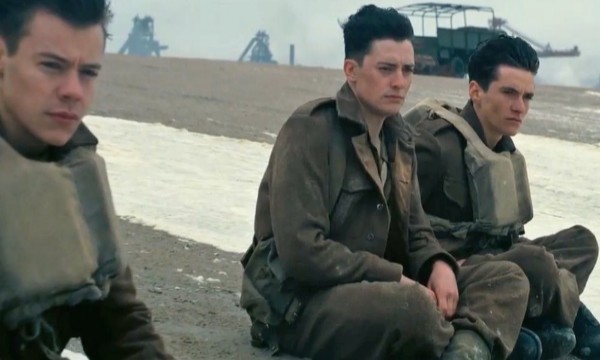Podcast voiced by Benjamin Huang and edited by Finn Mennuti.

A group of soldiers trudges down what was once an idyllic but is now deserted avenue in France. Paper pamphlets reading “WE SURROUND YOU” drift down from the sky like snow. Suddenly, shots from an unseen enemy ring out, and the soldiers, running for their lives, are cut down one by one — such is the opening of Christopher Nolan’s latest masterpiece, “Dunkirk.” With attention to detail, gripping suspense and a formula that offers a more nuanced take on a war film than the often-cliché Hollywood favorites, the Oscar-nominee wholly deserves its critical acclaim.
“Dunkirk” chronicles the famed evacuation of Allied troops from France from three points of view: the mole (referring to the pier from which soldiers are loaded onto boats), the sea and the air. Tommy (Fionn Whitehead), a young British pilot, struggles to stay alive as the masses of men awaiting help on the beach are bombarded by German dive-bombers. Racing to the soldiers’ rescue is a fleet of civilian boats, including Moonstone, captained by Mr. Dawson (Mark Rylance). Watching over all of them from the air are Royal Air Force pilots Farrier (Tom Hardy) and Collins (Jack Lowden), deftly navigating Spitfires and engaging with the Luftwaffe.
The portrayal of the evacuation, and its preceding events, is well-executed and perfectly complex. Nolan’s cinematography continues to impress throughout the film, featuring striking shots of long lines of men huddled together on the beach and aerial dogfights portrayed from the point of view of the pilots. In addition, the film simultaneously tells what are at first three separate stories through a nonlinear style, rapidly jumping between the three different viewpoints in different locations and even different times. The climax then ties together the three seemingly unrelated stories in a satisfying manner.
Unfortunately, the sparse dialogue throughout the movie limits the complexity of the characters. Other than a fuzzy impression of their personalities — for example, that Farrier is steadfast and unflinching — little is known about their backgrounds, motivations, flaws or other details. Many of the characters are static and undergo no notable changes in attitude or personality throughout the film. In essence, Nolan treats the characters more as lenses through which the audience experiences the evacuation at Dunkirk, instead of people whom the audience should care about. Part of this shortcoming can be excused by the film’s lean 106-minute runtime, which leaves little time for meaningful discussion between characters.
To make up for the lack of dialogue, there are notable onscreen performances by Cillian Murphy, who plays a shell-shocked, blankly staring soldier rescued by the Moonstone, as well as Harry Styles, who makes a curious cameo appearance.
“Dunkirk” puts on display the best of composer Hans Zimmer; though much of the soundtrack lacks technicality, the music effectively contributes to the overall suspense. The metronomical, staccato music throughout the film serves as a persistent reminder that time is running out. “Dunkirk” also deserves mention for its minimal use of CGI or post-production effects. In the process of making the film, Nolan hired 1,000 extras and used thousands of cardboard cutouts to create the impression of a large army. Nolan also employed large, heavy IMAX cameras on the wings of the planes to create more realistic dogfight scenes.
Perhaps the most defining feature of “Dunkirk” is that it is largely a realistic depiction of war. With the exception of one instance, it avoids overly convenient rescues, and the limited dialogue also helps to steer clear of the usual military clichés. It avoids the untempered — albeit truthful — goriness of the World War II classic “Saving Private Ryan.” There are no scenes of dying heroes whispering philosophical musings, or colorful bands of soldiers made up of the stereotypical Hollywood assortment.
“Dunkirk” is one of those rare Hollywood war films that manages to not only do justice to the events portrayed through superb directing, screenplay and acting, but avoids the injection of stale clichés and tropes that would otherwise dampen the film’s impact.
“Dunkirk”
1 hour, 46 minutes.
PG-13 for intense war experience and some language
Directed by Christopher Nolan
Starring Tom Hardy, Fionn Whitehead, and Mark Rylance




